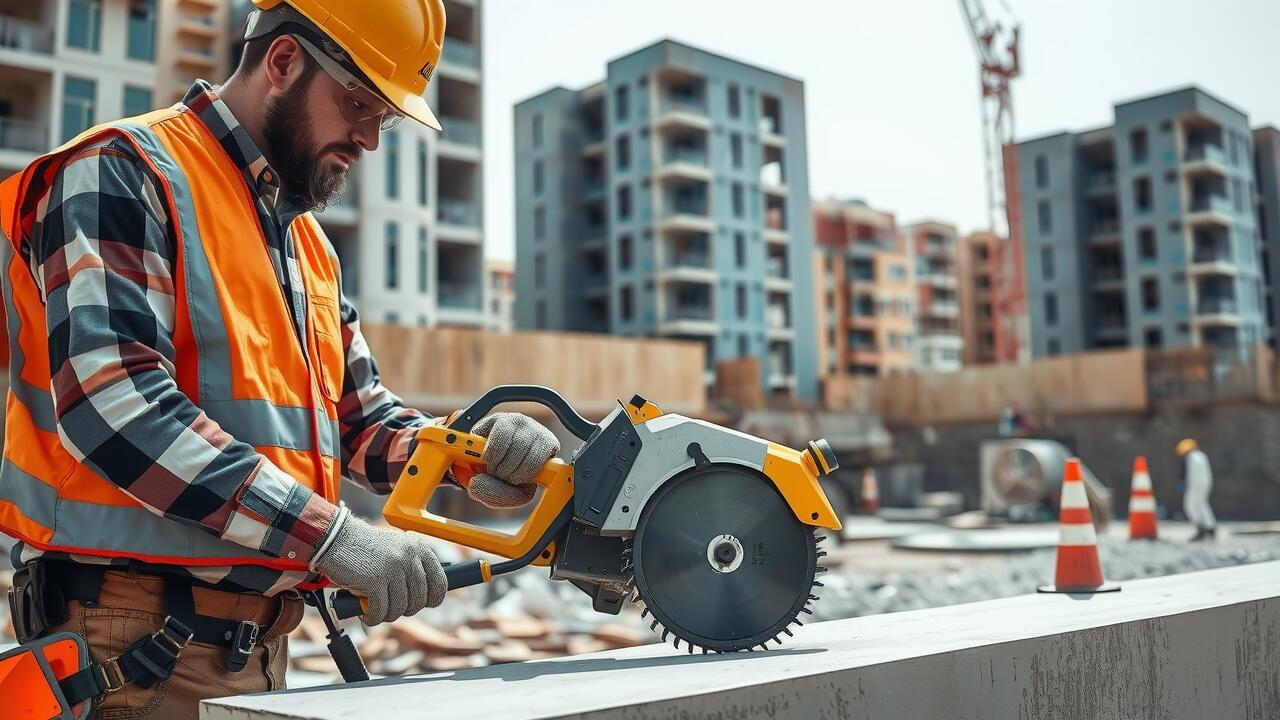
Table Of Contents
Handheld Concrete Saws
Handheld concrete saws are versatile tools commonly used in various construction and demolition projects. These saws offer the advantage of portability, allowing users to reach tight spaces and cut through concrete with ease. They are equipped with powerful engines and capable blades that can slice through different types of concrete surfaces, making them suitable for both professional contractors and DIY enthusiasts. The lightweight design further enhances their maneuverability, enabling operators to perform intricate cuts or make adjustments on-site without needing heavy equipment.
In the realm of concrete cutting, handheld saws excel in a variety of applications. They are particularly advantageous for cutting to a precise depth, which is crucial in tasks such as creating control joints or removing damaged sections of concrete. Users can choose from different blade types, including diamond blades, to optimize performance based on the specific job requirements. With proper technique and maintenance, handheld concrete saws ensure that cutting tasks are efficiently executed, leading to clean, accurate results.
Ideal Use Cases for Handheld Saws
Handheld concrete saws are versatile tools frequently utilized for a variety of concrete cutting applications. They excel in tight spaces and when precise cuts are needed. Ideal scenarios often include residential renovations where cutting through walls or floors is necessary. These saws allow for quick and efficient adjustments, which makes them suitable for projects requiring different angles or depths.
The portability of handheld concrete saws enables easy maneuvering around obstacles, making them perfect for smaller jobs or locations where larger saws cannot reach. They are effective for cutting concrete driveways, sidewalks, and curbs as well. Their ability to accommodate various blade types also enhances their functionality, allowing contractors to tackle diverse tasks in concrete cutting with ease.
Floor Sawing
Floor sawing is an essential technique in concrete cutting, particularly suitable for creating expansion joints, trenches, or removing damaged sections. This method uses a specialized saw mounted on a wheeled frame, allowing for precise horizontal cuts on flat surfaces. It is ideal for large areas where other tools may be less efficient. The average depth of a floor saw cut can range from a quarter-inch to over a foot, depending on the project requirements and blade type.
Proper technique and equipment selection are crucial for effective floor sawing. Operators need to consider the diameter of the saw blade and the power source, whether it’s electric, gas, or diesel. These factors contribute to the cutting speed and dust management. Additionally, maintaining the appropriate water flow during operation minimizes dust and heat, ensuring a cleaner cut and prolonging the life of the blade. Effective floor sawing supports a variety of construction and renovation projects, making it a valuable method in concrete cutting.
Techniques for Effective Floor Sawing
Effective floor sawing techniques play a crucial role in achieving clean cuts in concrete surfaces. Selecting the right saw is essential. Floor saws equipped with diamond blades are commonly used for their efficiency and precision. Before starting, it is important to assess the concrete’s thickness and density. This evaluation helps determine the suitable blade type and cutting depth. Proper blade maintenance also ensures optimal performance during the cutting process, minimizing the risk of wear.
Operator safety is paramount during floor sawing. Wearing appropriate personal protective equipment, such as goggles and ear protection, helps safeguard against debris and noise. Additionally, establishing a clear cutting plan can enhance efficiency. Marking cut lines accurately on the concrete provides a guide, reducing the likelihood of errors. Understanding the nuances of concrete and ensuring the right techniques are followed contribute to successful concrete cutting, leading to a flawless finish.
Hydraulic Concrete Cutting
Hydraulic concrete cutting utilizes powerful hydraulic systems to drive cutting tools through dense materials. This method is particularly effective for large-scale projects where precision and strength are necessary. By leveraging the immense pressure generated by hydraulic equipment, operators can achieve clean cuts in reinforced concrete, making it ideal for heavy-duty applications such as road repairs and construction of infrastructure.
The precision offered by hydraulic systems enhances the accuracy of cuts, minimizing the risk of damage to surrounding materials. The ability to control the pressure and speed allows operators to adapt to various types of concrete conditions. Additionally, hydraulic concrete cutting is less noisy and produces fewer vibrations compared to traditional methods, making it favorable for use in urban environments where noise control is a priority.
The Role of Hydraulics in Precision Cutting
Hydraulic concrete cutting tools leverage high-pressure fluids to power precision-cutting blades, ensuring clean, accurate results. This technology is particularly beneficial in situations requiring intricate cuts, such as those found in reinforced concrete structures. The ability to maintain consistent power allows operators to achieve uniform cuts quickly, reducing the risk of error that can occur with manual cutting methods.
In addition to enhancing accuracy, hydraulic systems also reduce operator fatigue, making it easier to handle demanding projects. These tools are effective in various scenarios, including demolition and renovation tasks. The versatility and efficiency of hydraulic concrete cutting are cornerstones for contractors seeking high-quality outcomes in their work.
FAQS
What are handheld concrete saws used for?
Handheld concrete saws are primarily used for making precise cuts in concrete, masonry, and asphalt. They are ideal for smaller jobs and can be utilized in confined spaces.
What are the ideal use cases for handheld saws?
Handheld saws are best suited for tasks such as cutting control joints, repairing pavement, and making small openings for pipes or electrical conduits.
What is floor sawing and when is it used?
Floor sawing involves cutting horizontal surfaces, typically concrete floors, to create expansion joints, repair damage, or prepare for new installations. It is often used in construction and renovation projects.
What techniques can enhance effective floor sawing?
Effective floor sawing can be enhanced by using the right blade for the material, maintaining consistent speed, ensuring proper cooling of the blade, and marking clear guidelines for accurate cuts.
How does hydraulic concrete cutting work?
Hydraulic concrete cutting utilizes hydraulic power to drive saw blades, allowing for more precise and efficient cutting. This method is especially useful for large or thick concrete structures.
What are the benefits of using hydraulics in precision cutting?
The benefits of using hydraulics in precision cutting include increased cutting speed, reduced operator fatigue, enhanced control, and the ability to make deeper cuts with minimal effort.

